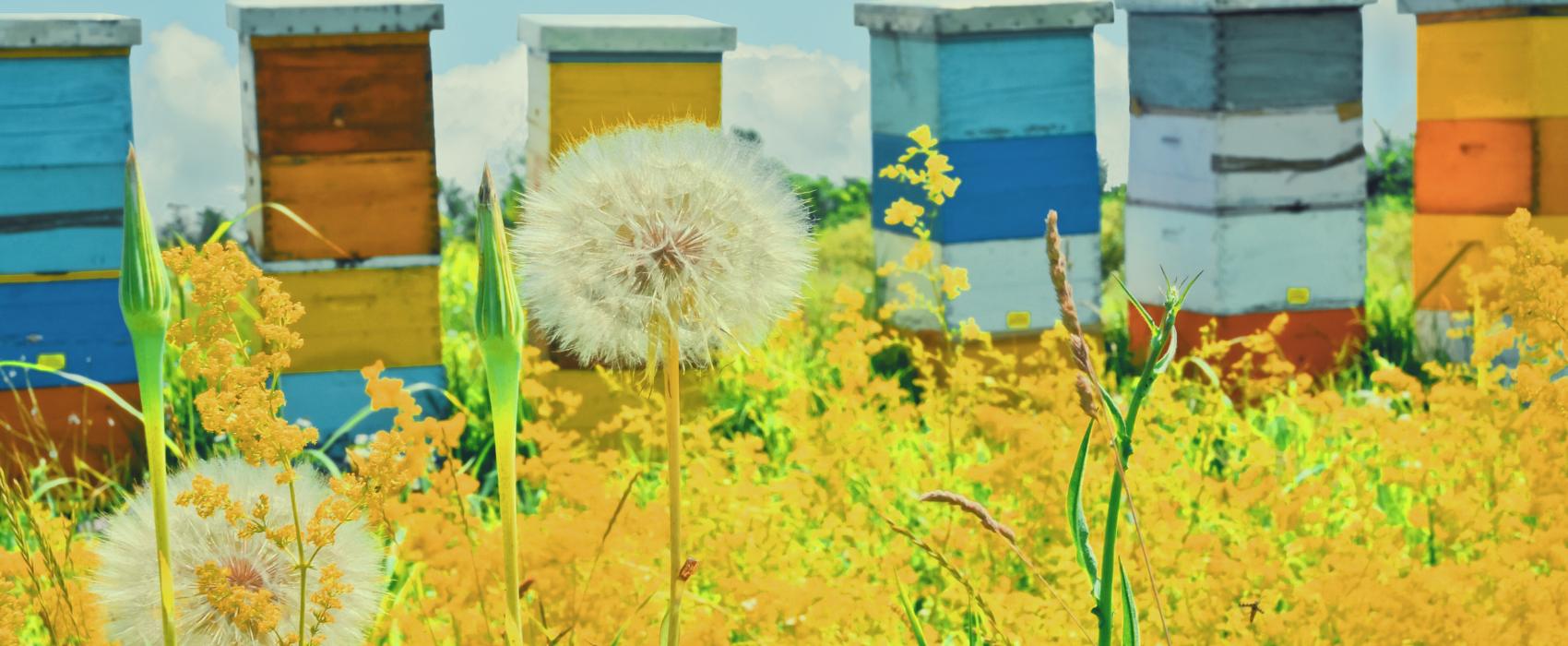Mother Nature stopped the rain for one hour for our March Apiary Series at Clark Botanic Garden; she must bee appreciating our efforts to learn more about the world we live in!
Note the pretty blooming tree and umbrella that you won’t find the picture we took last month! You’ll note we still had coats on – the weather was less than perfect…but we still came! Not everything went as planned, but we still managed to focus on the topic of the month: pollen.

March in the Apiary: what did we do?
We took a walk-about the Garden, coming to the apiary from a different direction. The goal was to talk about pollen and bee able to see it and compare it on the various flowers that were in bloom. Most flowers close up their petals in the rain, and it was a little challenging to do that – we tried though!
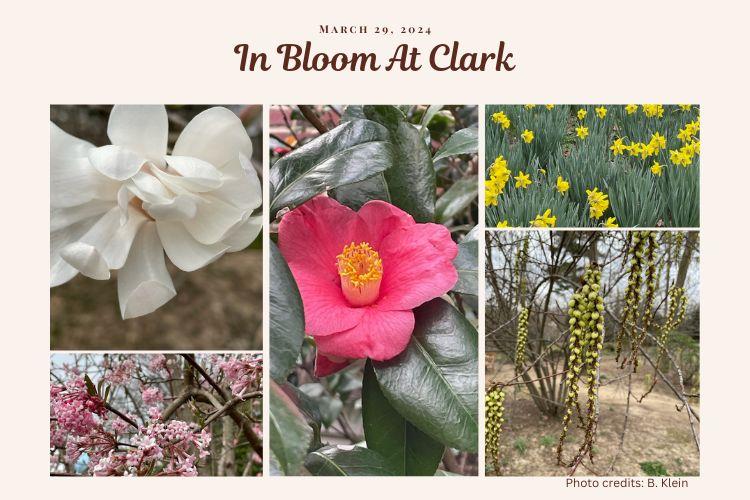
Topic of the Month: Pollen
Everyone kind-of, sort-of, knows what pollen; it’s a word that’s used frequently when talking about plants, bees, and even allergies. Beekeepers keep an eye on the bottom board (remember what that is? we learned about it in February!) in the springtime to make sure the bees are bringing some pollen back to the hive.
What is Pollen?
Pollen is a powdery substance made by plants to help them reproduce. Pollen is made by flowering plants, trees, grasses and even weeds.
Pollen comes in many different colors! When you see a bee carrying some green pollen, for example, you can try to guess what plant they may have visited to collect it.
According to this chart, and green pollen could be buckwheat, knapweed, bell heath, or meadowsweet. It’s easier to narrow things down when you know exactly what plants grow around your bee hives.
Personally, I have never seen any shade of blue pollen come in my hives! But somewhere in the USA, apparently you’ll find blue-ish pollen from the fireweed plant!
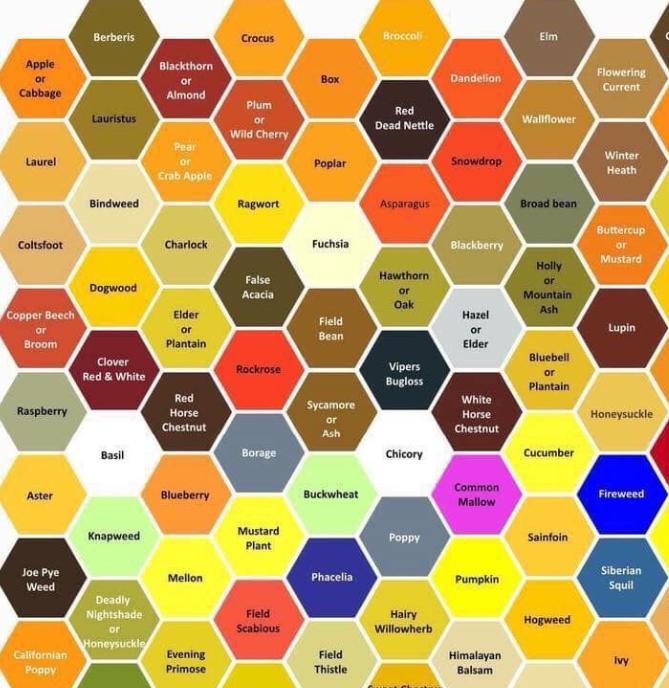
If the weather wasn’t so wet, we would have been able to examine more flowers in our walk-about, but we did see daffodils loaded with orange and yellow pollen. Pollen sits on the top of filaments, on top of the anthers, in daffodils. NOTE: Daffodils provide early spring pollen but they also shelter and heat for bees at the beginning of the season; this beautiful short article from the Washington Post can tell you more.
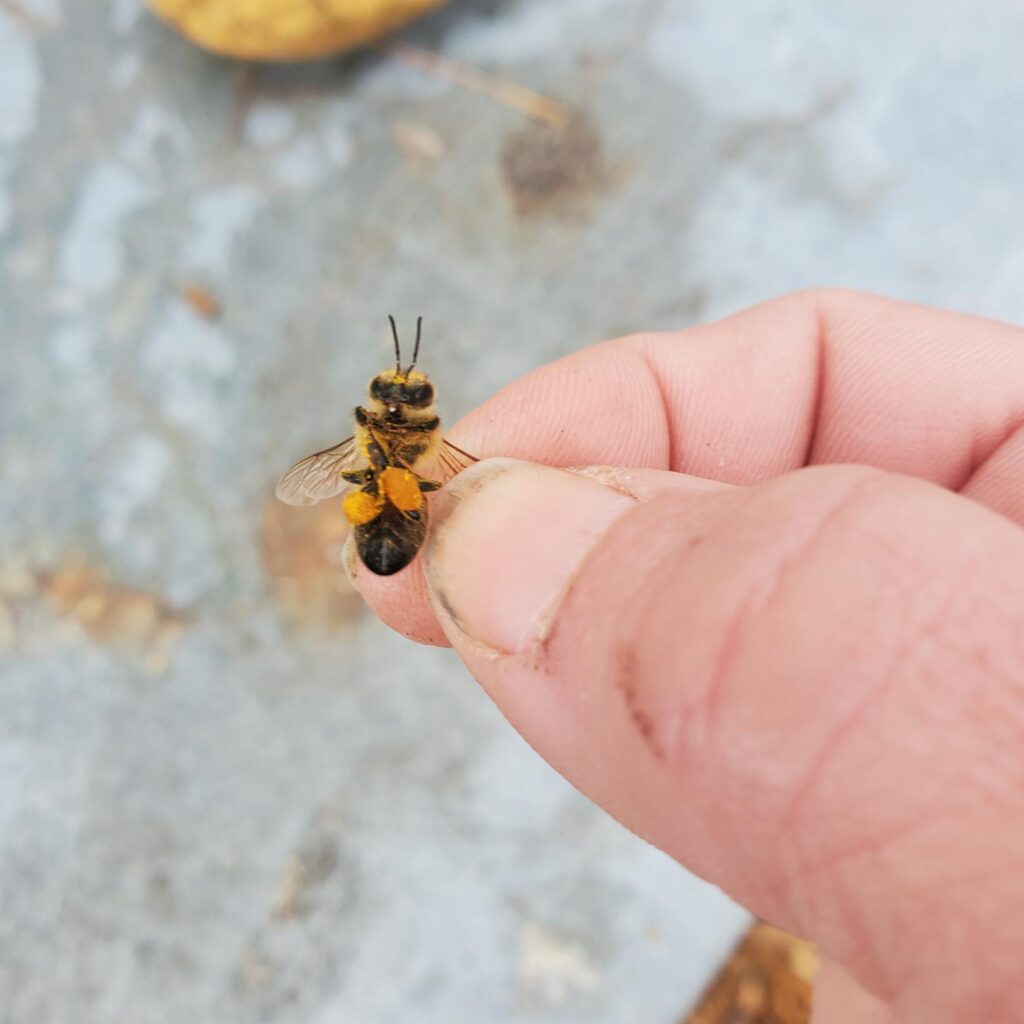
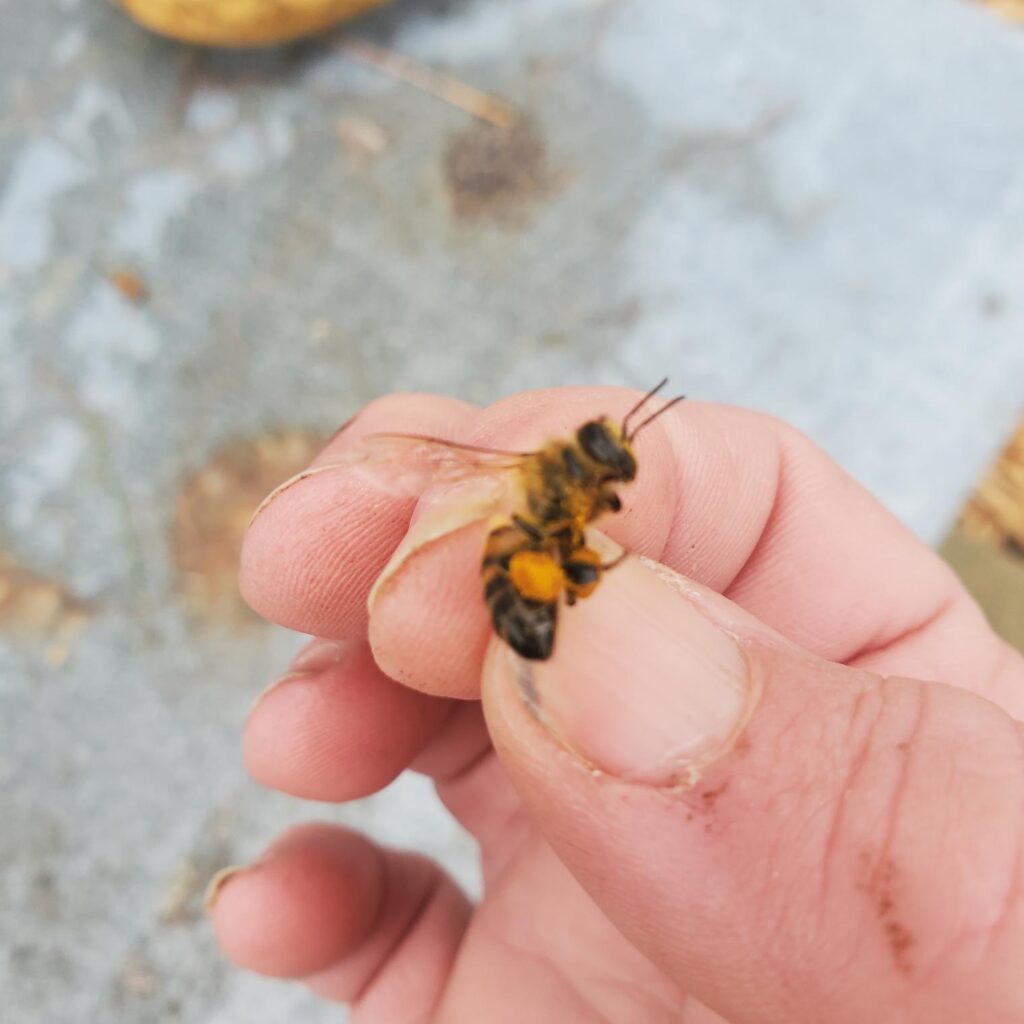

Pollen Baskets
Honeybees primarily feed on nectar from the flowers they visit. Nectar provides much needed energy, as well as some antimicrobial enzymes that help to maintain honeybee health. Pollen provides the bees with other nutrients, and it is essential at this time of the year when the hive is expanding quickly.
Bees fly everywhere but they also have very important legs! Honeybees mix pollen with a little nectar, and use their pollen press (in the joint of their hind leg) to form pollen packs, which they carry back to the hive.
A bee can carry up to 35% of their body weight in pollen! Sometimes it appears that they are “drunk” – they don’t fly straight, miss the landing board, or run into things because they are so loaded down with pollen.
Bee bread
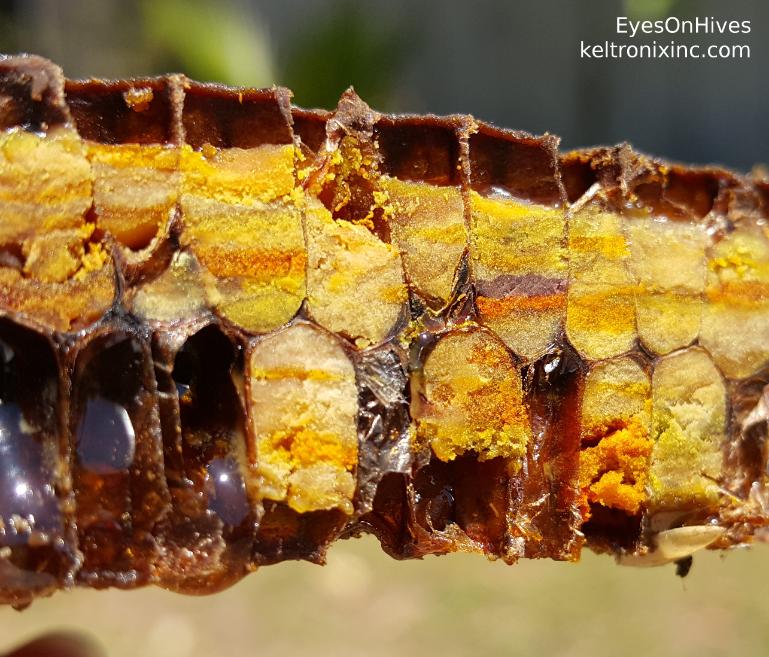
Pollen is the main ingredient in bee bread, a special recipe the bees make to aid the development of larva into adult bees. Pollen, mixed with nectar, honey, and saliva, is fermented inside the cells of a beehive for approximately 7 days, to make bee bread.
The nurse bees feed the finished bee bread to the larva, the second stage of life for a bee. (Bees go through a metamorphosis process, like butterflies, in 4 stages – egg, larva, pupa, adult).
Pollen is an essential source of protein for the larvae and the need for pollen is highest in the springtime.
Pollination
Bees are also essential pollinators. Apart from using pollen for their own ‘personal use’, they are ‘movers and shakers’ that carry pollen from one plant to another. When the pollen (male) connects with the ovaries of a plant (female), the plant is able to reproduce. A fertilized flower on an apple tree, for example, will produce an apple, which contains seeds inside to make more apple trees. Nature is amazing in so many ways.
“If the bee disappeared off the surface of the globe, then man would have only four years of life left. No more bees, no more pollination, no more plants, no more animals, no more man.”
Albert Einstein
While there are many insects that help with pollination, honey bees are responsible for about 80% of all pollination. Without them, farmers would have to hand pollinate the crops and that would be pretty impossible to do as efficiently as a honey bee!

March Observations
Our visit to the apiary was much warmer than last month (it was 52 degrees), but it was much wetter. Once again, it wasn’t “sit in the sun and draw” kind of weather. (April showers bring May flowers, so let’s hope we have better luck in April)
We DID see honey bees flying this month, but not as many as you’ll see next month. One thing we did note is the direction the bees fly….out of the hive (from their south facing doorway) and UP. Ideally all hives face southeast and we noticed all the hives were facing the same way!.
We did another quick count of visible bee activity at the 10 hives. If you remember, last month we thought 5 out of 10 hives did not make it through the winter. Based on our observations today, it seems that may be accurate. We only saw 3 hives that were significantly active, and 2 others only had a few very hesitant honeybees hovering near the bottom board entry way. Very concerning…
| TOTAL # HIVES | 10 |
| Presumed dead: hives with significant dead bees on bottom board; no signs of bees taking cleansing flights, temperatures still going into the 30’s; too cold to investigate by opening up the hives | 5 |
| Weather on day of class | 52 degrees F, wet |
| Number of participants | 13 |
| Plants in Bloom | Daffodils, magnolia, camelia, vinca, |
In between our February and March meet-ups, the Queen did visit the apiary on her own. On that beautiful sunny day, she saw activity on 10 out of 10 hives, so she’s not gonna give up yet. But you can understand why the drastic changes in temperature are really challenging for the little honey bees.
We did find one bee on the bottom board of a hive that must have carried a bunch of pollen home, and then froze before it made it into the safety and warmth of the hive. Or maybe, the pollen was so heavy that she landed on the wrong bottom board. At any rate, we were able to see real pollen packs up close and personal, which was a treat…because who wants to just listen? It’s so much better to see nature in action!
Thank You Surprises
We played a small “lucky number guess” game and the prize was a jar of Elderberry Honey. The honey had been infused with pink elderberries that turned the honey a lovely shade of pink! Elderberry honey is prized for it’s immunological properties.
Last Word on Pollen
Pollen is a major allergen for many people; the particles are so small and light that the wind can carry it for miles. Pollen counts are measured by collecting and analyzing the pollen in the air over 24 hours. Weather reports include pollen forecasts to help allergy sufferers know what to expect.
Many people believe that local honey includes pollen particles that may help alleviate their allergy symptoms. I have to bee honest; the research on this claim is very scanty.
In very small studies, a daily teaspoon of local raw honey may reduce allergy symptoms but the dosage needs to start at least 6 weeks before the allergy season starts. Most people think that taking a teaspoon of honey will have an immediate effect, like an aspirin.
Don’t bee fooled. Honey has many wonderful properties, but it is not a quick acting allergy cure.
Bee In Touch
Our next meeting is on April 25th and I’m already excited to share the changes in the Garden and the bee yard with you! We’ll send you a reminder e-mail and you can message us if you have any outstanding questions. You can also follow Backyard Bees over on our Facebook page or Instagram account.
If you’d like to support the Backyard Bees Apiary, we welcome donations for purchase of supplies. We are specifically working towards an observation hive which costs approximately $300, but our first priority is making sure we have live bees in all the hives – a new colony of bees costs $200, and any little bit helps!
BEE WELL! See you soon for the April Apiary! xoxo The Queen Bee!
